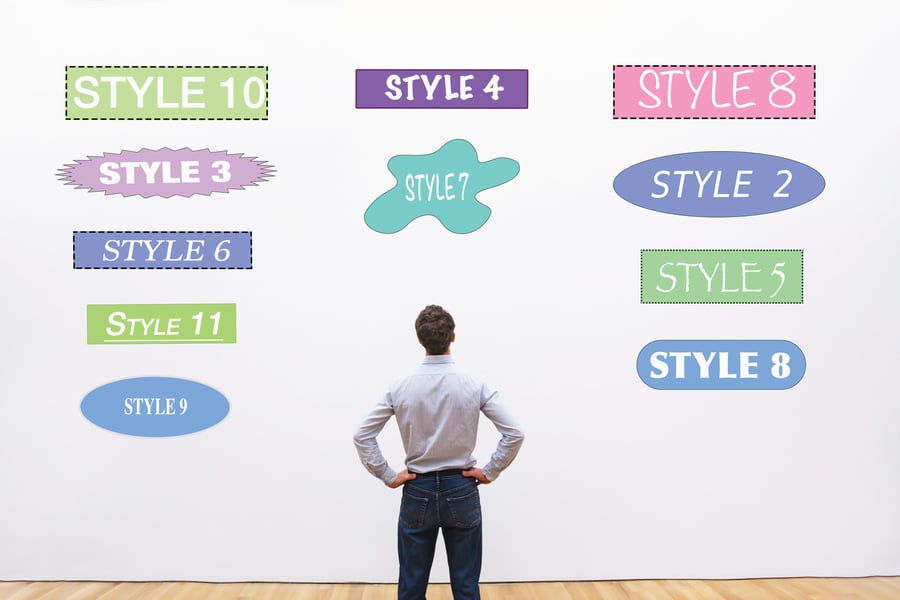
Blog

What’s the Difference between a Font and a Typeface
When it comes to the ink-smudged world of typesetting, you would assume that the terminology employed would be simple and straightforward, or to put it in printing terms, in “black and white.”
Of course, if this was your assumption, then you would be as wrong as those who insist on using a frivolous font such as Comic Sans in legal documents and work emails.
No Joke: Comic Sans is a Typeface … and a Font!
For starters, Comic Sans in broad terms is technically a typeface and not a font.
Garamond. Helvetica. Arial. Times New Roman. Same! All of them are typefaces … but most of us call them fonts!
“A typeface is the same thing as a font, right? Not exactly. Although the words are often used interchangeably, there’s a difference between a typeface vs. font. And it’s a nuanced difference that can sometimes be confusing,” explains copywriter Lindsay Kramer on 99designs by Vista. “While a typeface is a set of design features for letters and other characters, a font is the variation in weight and size of a typeface.”
So, 28 pt Arial Bold, Times New Roman Italic, and Bodoni MT Black are all separate fonts designed off popular typefaces.
For that fact, 12-point Helvetica, 14-point Helvetica, and so on, are all different fonts based on the typeface Helvetica.
Do not feel bad if this is news to you, as many in the typesetting industry swap the terms indiscriminately.
“One of the things we get asked all the time, from designers and non-designers alike, is what the heck the difference is between a font and a typeface,” wrote Micah Rich in the League of Moveable Type.
And that variation of Comic Sans you find on your Microsoft Word dropdown (Comic Sans MS) is a font – but keep in mind the creator of Comic Sans, Vincent Connare in 1994, designed the typeface for the speech bubbles of an animated cartoon dog and thought it would only be used for kids, so think twice before using it in the funeral program for your favorite great uncle (unless, of course, he was a real jokester and would have appreciated the irony).
Unpacking the Terminology: Typeface vs. Font vs. Typesetting
Let's look deeper into the terminology to understand the differences between typeface, font, and typesetting:
- Typefaces: A typeface is a design for a set of characters. It is defined by the overall style and appearance of the characters, including their shape, size, and spacing. Some popular typefaces include Times New Roman, Arial, and Helvetica.
- Fonts: A font is a specific realization of a typeface. It is defined by the physical characteristics of the characters, such as their height, width, and weight. For example, Times New Roman Regular and Times New Roman Bold are two different fonts of the same typeface.
- Typesetting: Typesetting is the process of arranging and formatting text to create a visually appealing and readable page. It involves choosing the right typeface, font, size, and spacing for the text. Typesetting can be done manually or using a computer program.
Rich describes the differences as a typeface is the visual design of a collection of characters, like letters, numerals, symbols, etc. while a font is the piece of software you install on your computer that allows you to use a typeface.
“In the ancient days before computers, a font was a collection of metal pieces you would use to set the type,” explains Rich.
There are also legal ramifications in the United States when it comes to the differences between typefaces and fonts as, according to the Georgia Lawyers for the Arts, fonts are protectable under copyright law, but typefaces are not.
The reasoning behind this? Typefaces are considered functional works, rather than works of art, while fonts are considered to be specific expressions of typefaces,
In the end, designers utilize both typefaces and fonts to make their art.
“Typography is how text is arranged within a design. It’s the process of working out how to make the text fit in an aesthetically pleasing way that doesn’t compromise its legibility. With typography, the designer isn’t designing the actual letters, they’re working with existing typefaces and fonts,” writes Kramer.
History of Typesetting: From Gutenberg to Open Type
Typesetting has a long and fascinating history. It began in the 15th century with the invention of the printing press.
At first, typesetting was done by hand, one letter at a time. This was a slow and tedious process, but it produced high-quality results.
“In 1440, when Johannes Gutenberg invented the printing press to mass-produce Bibles, his books came with another innovation: the first font,” writes Sara Friedman in The Hustle.
- 1440: The printing press was invented by Johannes Gutenberg, using Blackletter typefaces.
- 1470: More readable Roman Type is designed by Nicolas Jenson, combining Italian Humanist lettering with Blackletter.
- 1501: Aldus Manutius and Francesco Griffo create the first italic typeface, which allows prints to fit more text on each page.
- 1734: William Caslon creates what is now known as “Old Style” type, with more contrast between strokes.
- 1757: John Baskerville creates Transitional typefaces, with even more contrast than Old Style type.
- 1780: The first “modern” Roman typefaces – Didot and Bodoni – are created.
- 1815: The first Egyptian, or Slab Serif, typeface was created by Vincent Figgins.
- 1816: The first sans-serif typeface was created by William Caslon IV.
- 1916: Edward Johnston designs the iconic sans-serif typeface used by London’s Underground system.
- 1920: Frederic Goudy becomes the first full-time type designer, and creates Copperplate Gothic and Goudy Old Style, among others.
- 1957: Helvetica is created by Max Miedinger. Other minimalist modern sans-serif typefaces, including Futura, emerged around this time.
- 1968: The first digital typeface, Digi Grotesk, was designed by Rudolf Hell.
- 1974: Outline (vector) fonts are developed for digital typefaces, resulting in smaller file sizes and less computer memory usage.
- Late 1980s: TrueType fonts are created, resulting in a single file being used for both computer displays and output devices such as printers.
- 1997: Open Type fonts are invented, which allow for cross-platform use on Macs and PCs.
- 1997: CSS incorporates the first-ever font styling rules.
- 1998: Web Fonts are made possible with the release of Internet Explorer 4 but aren’t widely adopted.
- 2009: The Web Open Font Format (WOFF) is developed and added to the W3C open standard for the web.
- 2011: All major browsers adopt support for WOFF.
- 2016: Open Type adopts variable fonts, a single font file that can change shape, width, thickness, and slant based on where it’s used in an interface.
Monotype: The Biggest Player in Typefaces and Fonts
Monotype is a leading provider of typefaces and fonts. The company was founded in 1887 and has a long history of innovation. Monotype is credited with creating some of the most popular fonts in the world, including Times New Roman, Gills Sans, Perpetua, and Arial, and has acquired other companies that created such favorite fonts as Helvetica.
Friedman in her story says that Monotype is becoming a monolith in the typesetting industry.
“It’s only getting harder, as designers must compete with and abide by the terms of one company that’s approaching behemoth status: Monotype,” writes Friedman. “The company owns not only many of the world’s most popular fonts but also exchanges like MyFonts where font designers bring their work to market. The industry is inching toward a monopoly, and it’s leaving independent designers with fewer places to go.”
Monotype was named for the monotype machine invention by its founder Tolbert Lanston, which allowed for increased speed and efficiency when producing type, says Friedman.
The owners of Monotype have been on a buying binge over the past 20 years:
- Purchased Linotype (creator of Helvetica and about 6,000 other typefaces) in 2006.
- Acquired China Type Design in 2006.
- Bought Planetweb in 2009.
- Bought Ascender Corporation, a digital typeface foundry, in 2010.
- In 2012, bought Bitstream Inc., a digital font retailer, which also gave it ownership of the MyFonts font sale website, considered by many to be the gold standard of font design.
- Purchased FontShop, creator of more than 2,500 typefaces, in 2014.
- In 2020, added FontSmith, an independent London foundry.
- In 2020, purchased URW Type Foundry.
- Acquired Hoefler & Co. and its well-known font libraries such as Gotham, Knockout, Mercury, Sentinel, Chronicle, Decimal, and Archer in 2021.
- In 2023 bought Japanese type foundry Fontworks.
Font Exchanges: How They Work
Font exchanges are marketplaces where designers, businesses, and individuals can discover, purchase, and sell fonts. These platforms offer a wide variety of fonts, from classic to contemporary, and cater to various design needs.
Here's how font exchanges typically work:
- Browsing: Users can browse through a vast collection of fonts, each with its own style, weight, and licensing options.
- Licensing: Fonts are available for purchase with different licensing options, allowing for personal and commercial use. Users can choose the license that suits their project requirements.
- Preview: Most exchanges provide tools to preview the font's appearance, style variations, and compatibility before purchase.
- Download: After selecting and purchasing a font, users can download the font files in their chosen format (e.g., TrueType or OpenType) and start using them in their projects.
Through its acquisitions, Monotype is the major font player, and not everyone is excited about so many of the world’s fonts in the hands of a single entity – especially one that takes a 50 percent cut of every sale on MyFonts.
“When you’re independent, you’ve got your freedom, which is great. But then you have to balance being overlooked, and trying to beat [MyFonts] because they are a monster,” Ellen Luff of Ellen Luff Type Foundry told The Hustle. “They are huge.”
Others in The Hustle article, credit MyFonts with boosting their designing careers.
“I decided to go full-time as an independent type designer less than 18 months after my first release at MyFonts,”Paulo Goode told Frieman. “I haven’t looked back since.”
The Hustle article notes that the font world is anything but static with MyFont introducing a new subscription model that the company says will put more money in the pockets of designers, but some designers are skeptical about the change.
And then there is artificial intelligence (AI), which is disrupting every industry it seems, and typesetting is no exception.
“AI can now set (almost) perfect typography,” reported Fast Company earlier this year.
Fast Company announced the release of Deep Floyd, “a generative AI capable of setting perfect typography in any setting made of any material under any conditions imaginable. Most other generative AI platforms render text as a garbled mess, which makes this release big news. It’s the first time scientists have achieved not only legible text but beautifully made text.”
Gutenberg and the Comic Sans cartoon dog would both be impressed.
Subscribe to email updates
Recent posts

Related Articles

Topics

Topics

Topics






